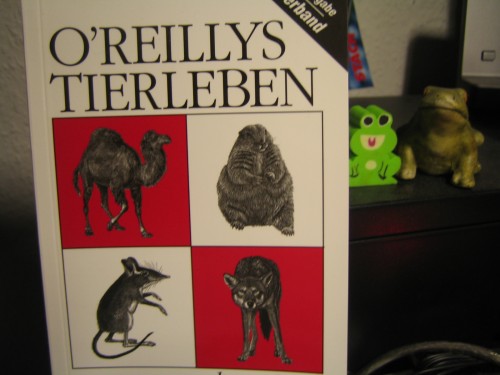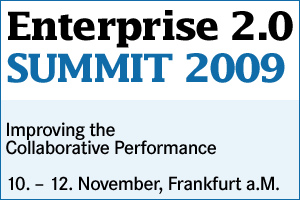Nächste Woche ist der Terminkalender prall gefüllt – u.a. steht Mittwoch der Besuch der Prio Conference in München an, am Donnerstag dann der Confluence Community Day in Frankfurt (hier schon erwähnt: “Speaking at Confluence Community Day“).

Weil mich der ein oder andere gefragt hat warum ein Enterprise 2.0 Berater auf eine .Net -Konferenz geht (gute Frage, ja), hier ein paar ebenso gute Gründe:
Zum einen geht es bei der Prio Conference dieses Jahr zentral um User Interfaces – und das wiederum ist für einen Berater der sich u.a. mit der Usability von Wikis beschäftigt erst einmal spannend. In der Vergangenheit habe ich so u.a. bei DesignCamps zum Thema mitgearbeitet und auch immer wieder die Zusammenhänge von Usability und Akzeptanz in diesem Blog beleuchtet. Und ja, ich bin mir nach wie vor sehr sicher dass angenehme Benutzeroberflächen – gerade bei Collaboration Software – von sehr großer Bedeutung sind. Anders als in traditionellen IT-Ansätzen (und Enterprise Software) können die Nutzer nicht gezwungen werden die Lösungen zu verwenden, umso mehr muss Collaboration Software nahtlos in die täglichen Arbeitsprozesse eingebunden werden um Nutzen zu erzeugen, hier stellen sich ganz automatisch Fragen von User Interfaces, Ergonomie und Usability.
Zum anderen ist es aber natürlich auch so dass die Agenda am Mittwoch einige spannende Vorträge verspricht, u.a.
- 09.00 – 09.45 Uhr die Keynote von Prof. Baudisch vom HPI, Berlin: Mein neuer PC ist ein Handy – Techniken und Technologien für die neue Kleinheit
- 10.15 – 11.30 Uhr: IT braucht Psychologen – Dieser Vortrag vertritt die Position, dass Ingenieur- und Arbeitspsychologen Technik, also auch Software, besser auf die Frage der Anwender vorbereiten können
- 11.45 – 13.00 Uhr: SharePoint und Silverlight – Wie kann Silverlight in SharePoint- Webparts eingesetzt werden, um ein besonders leistungsfähiges UI zu entwickeln?
- 11.45 – 13.00 Uhr: Understanding User Experience Design Patterns – Patterns are constructs or objects that repeat in a predictable manner. For most developers, patterns are directly related to object oriented coding best practices. In this talk, you will be introduced to “design patterns” that will help you build better user experiences. We’ll explore UX patterns that can help you build great user experiences, and provide examples of how you can start using them in your development today. We’ll cover patterns that pertain to different kinds of user interface problems such as commands, data entry, information architecture, navigation, page layout, and data visualization
- 16.00 – 17.15 Uhr: Natural User Interfaces: Ein neues Paradigma für Human-centred Design – Um User Interfaces für natürliche Interaktionen (wie z.B. Multitouch) zu entwickeln, muß man sich mit neuen Fragestellungen auseinander setzten. Es ist nicht damit getan, ein bestehendes UI zu “übertragen“. Um Natural User Interfaces zu unterstützen, müssen neue Interaktionskonzepte erdacht und gestaltet werden. Ganz im Sinne von Lichtenberg (1742–1799): “Dieses haben unsere Vorfahren aus gutem Grunde so geordnet, und wir stellen es aus gutem Grunde nun wieder ab.“ gelten neue Paradigmen.
OK, ich muss zugeben dass ich um 11:45 den Design Patterns zuneige, auch wenn es sehr reizvoll wäre zu sehen wie man Sharepoint (noch) hübscher machen kann …
Der letzte und entscheidende Grund ist aber dass ich in der Twitter-Verlosung des O’Reilly Verlags ein Prio Conf-Ticket gewonnen habe. Die Frage nach meinem O’Reilly-Buchcover Lieblingstier war ja auch wirklich einfach … Heute habe ich dann noch einmal in meinem umfangreichen O’Reilly Bücherregal gestöbert und das hier gefunden:

Zwar kein Ersatz für Brehm’s Tierleben, aber immerhin eine Erstauflage von 1999 (ja, die Frösche im Hintergrund sind kein Zufall …)
 After some good experiences at both the BarCamp Munich and the Enterprise 2.0 Conference in San Francisco it’s probably a good thing to expand the Google Wave experiment onto the upcoming E20SUMMIT. And while we don’t know how many of the attendees have got a Wave ID already, the more geeky ones sure have. And when Joachim Niemeier and I asked on Twitter if we should curate a Wave backchannel to the conference enough people raised their hand. After all there’s more than Twitter for getting more out of conferences – even when it can’t beat the face-to-face experience.
After some good experiences at both the BarCamp Munich and the Enterprise 2.0 Conference in San Francisco it’s probably a good thing to expand the Google Wave experiment onto the upcoming E20SUMMIT. And while we don’t know how many of the attendees have got a Wave ID already, the more geeky ones sure have. And when Joachim Niemeier and I asked on Twitter if we should curate a Wave backchannel to the conference enough people raised their hand. After all there’s more than Twitter for getting more out of conferences – even when it can’t beat the face-to-face experience.

